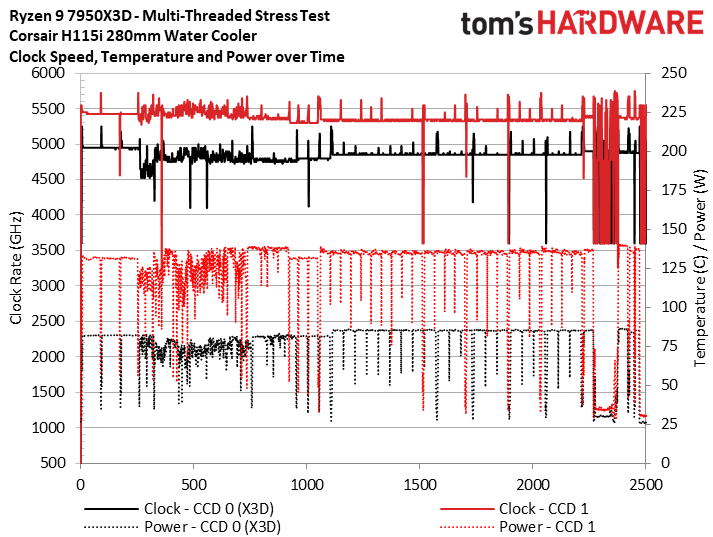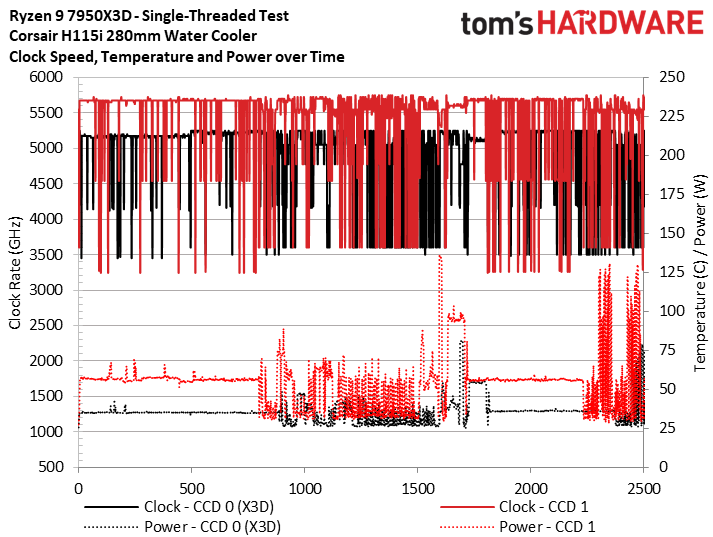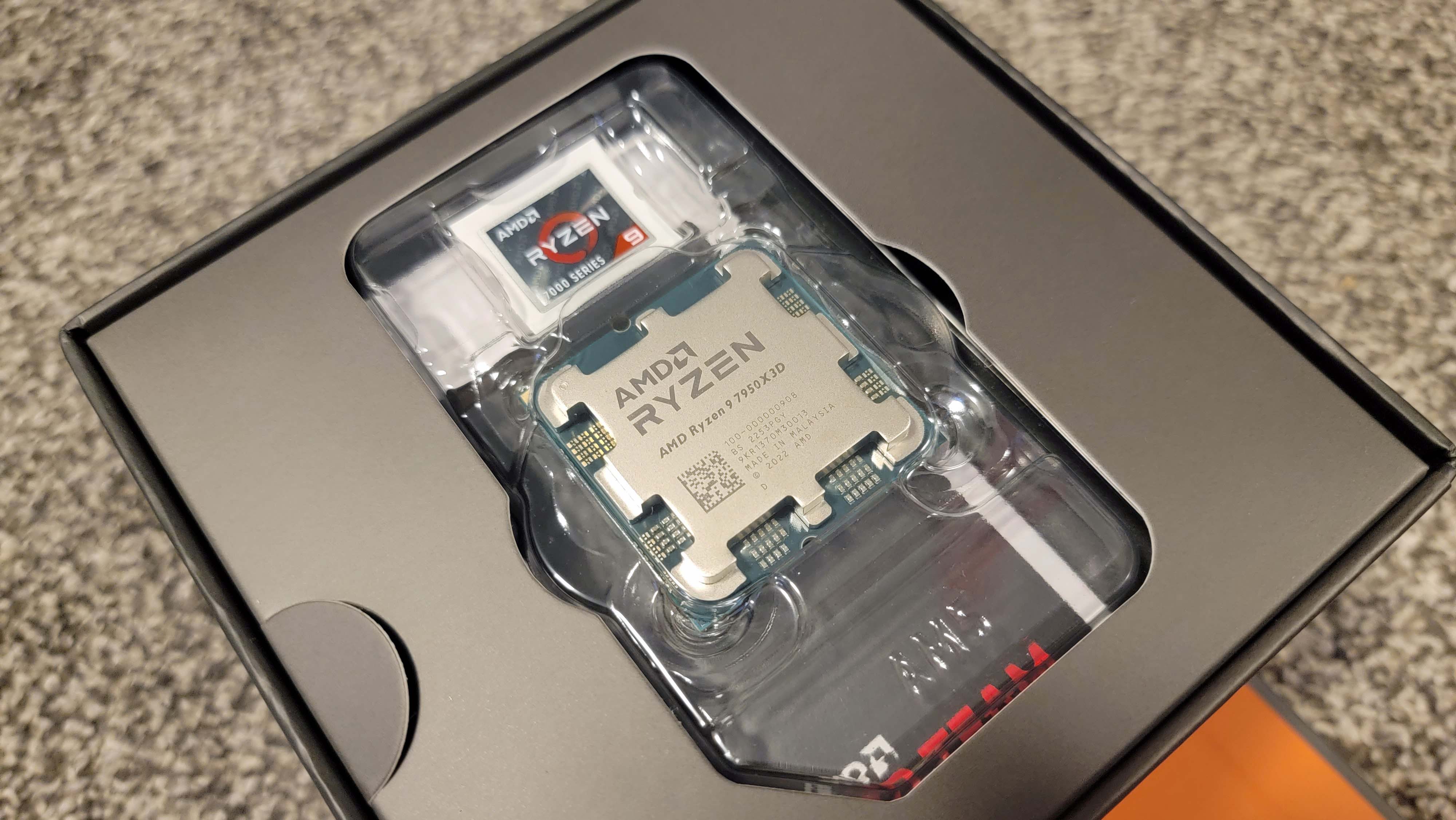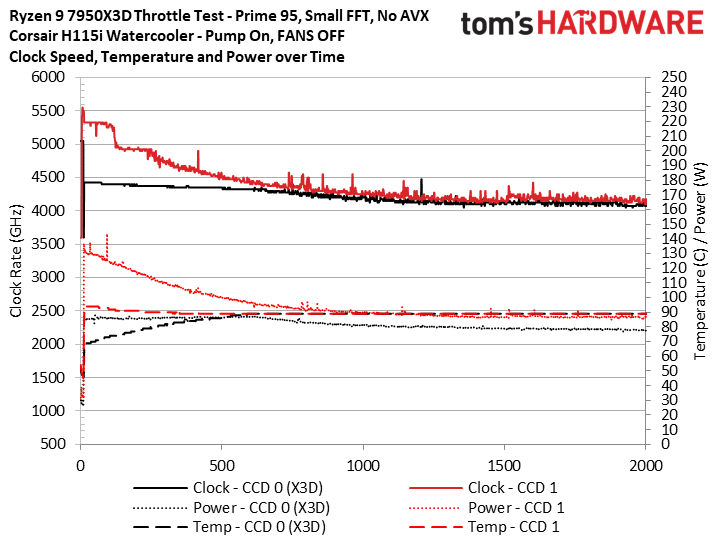Why you can trust Tom's Hardware
AMD Ryzen 9 7950X3D Chiplet Boost Frequencies, Voltages, Thermal, and Throttling Benchmarks
We turned our eyes to testing each chiplet individually to tease out the difference between the chiplets. The 7950X3D has two core compute die (CCD) chiplets lurking under the hood, and the CCD chiplet with the 3D V-Cache will run at lower clock speeds than the bare chiplet. This occurs because of the silicon shim stacked atop the CPU cores on the chiplet with 3D V-Cache — this shim transfers heat from the cores to the integrated heat spreader (IHS), but inevitably reduces the efficiency of the thermal transfer from the cores.
In effect, the shim traps a small amount of heat. As such, AMD sets a 1.4V limit for the entire processor, but further limits the 3D V-Cache CCD chiplet to ~1.1V to keep heat within safe boundaries. We put this to the test to generate hard numbers.


As you can see in the images above, we put the voltage and frequencies to the test by disabling one CCD and then running through a spate of standard heavily threaded applications (Cinebench, HandBrake, AVX-heavy y-cruncher) to measure power and thermals in multi-threaded work, and then another series of lightly-threaded apps to check performance in lighter fare. Then we tested the other chiplet using the same methodology.
| Tom's Hardware | Single-Threaded Peak | Multi-Threaded Sustained | nT Power | Voltage (peak) |
| CCD 0 (3D V-Cache) | 5.25 GHz | 4.85 GHz | 86W | 1.152 |
| CCD 1 (No extra cache) | 5.75 GHz | 5.3 GHz | 140W | 1.384 |
The tests above allowed us to generate this table with the frequencies and voltages for both CCDs. As you can see, the chiplet with 3D V-Cache (CCD 0) has single-core and multi-core clock rates of 5.25 and 4.85 GHz, respectively, significantly lower than the 5.75 and 5.3 GHz we measured with the chiplet without cache (CCD 1). We conducted these same tests with both CCDs active and easily achieved the rated 5.7 GHz boost, indicating AMD’s thread targeting implementation works correctly.
The 3D V-Cache chiplet also peaks at 1.152V during threaded work, while the bare chiplet peaks at 1.384V. This translates into much more power consumption — the bare chiplet pulls 140W when run alone, while the 3D V-Cache chiplet tops out at 86W. The bare CCD probably doesn’t sustain that level of power consumption often during normal usage due to both the additional heat from the other chiplet and power limits — we recorded a peak of 132W during a Prime95 workload for the entire chip with both CCDs active. That’s significantly lower than the rated 162W PPT limit.
Ryzen 9 7950X3D Thermal Throttling Tests
AMD specs an 89C limit for the Ryzen 9 7950X, lower than the 95C spec for the vanilla 7950X. We were curious if that limit applies to both chiplets, so we turned to a Prime95 test to take a closer look. We often don't include Prime95 power measurements in our standard CPU reviews, largely because there is a massive disconnect between this extremely rigorous stress test and most real-world applications' power consumption and thermal load. Still, we want to push the chips to their throttle point for this test.
To push the processor's limits even harder, we unplugged the fans on the Corsair H115i cooler but left the pump running (unplugging the pump caused clocks to drop too rapidly for our logging to provide any granularity). We then kicked off a Prime95 run with small FFTs, but with AVX instructions disabled. This type of Prime 95 stress test is brutal, and you won't see this type of stress during even the heaviest normal use. As such, remember that we're doing this for science, not as an indicator of how the chip would function in your PC.
The results show that the bare chiplet without the additional cache (CCD 1) reaches 94C before dropping to 89C when we remove the fan power. That 94C peak is actually above the rated 89C for the chip. Under normal circumstances, the chip would aggressively throttle power, and thus clock rates, to reduce thermals and stay under the target 89C. However, we can see that AMD allows this chiplet to run at a higher thermal threshold that matches the vanilla 7950X’s 95C limit.
In contrast, the chiplet with 3D V-Cache (CCD 0) never exceeds 89C, showing that it is programmed for the lower 89C threshold we see on the spec sheet.
You'll also notice that the bare chiplet begins the test around 140W and finishes at 90W when the chip is aggressively thermal throttling. In contrast, the 3D V-Cache CCD chiplet never exceeds 88W and hits a low of 78W at the end of the test. The 3D V-Cache CCD also drops to slightly lower clocks at the end of the test. That difference in power draw at the end of the test is largely due to the challenges associated with dissipating heat from the CPU cores covered by a silicon shim on the 3D V-Cache-equipped chiplet.
To be clear, you would never encounter these conditions during normal use, and the Ryzen 9 7950X3D runs perfectly fine within its specifications. Thermal dissipation has been one of the major sticking points that have prevented high-performance 3D-stacked chips from going mainstream, but AMD has done an amazing engineering job in bringing thermals under control enough to deliver a chip that provides excellent performance within an acceptable TDP threshold. Combining both a bare chiplet and a 3D-stacked chiplet is an ingenious design that helps provide the best of both worlds in a diverse range of workloads.
- MORE: Best CPU for gaming
- MORE: CPU Benchmark Hierarchy
- MORE: Intel vs AMD
- MORE: How to Overclock a CPU
Get Tom's Hardware's best news and in-depth reviews, straight to your inbox.
Current page: 7950X3D Chiplet Boosts, Voltage, Thermal, and Throttling Tests
Prev Page AMD Ryzen 9 7950X3D: 2nd-Gen 3D V-Cache Tech, Latency Testing Next Page AMD Ryzen 9 7950X3D: Power Consumption, Efficiency, Benchmark Setup
Paul Alcorn is the Editor-in-Chief for Tom's Hardware US. He also writes news and reviews on CPUs, storage, and enterprise hardware.
-
PlaneInTheSky ReplySteep pricing
The cons just weigh too heavy for me to even consider the CPU or the AM5 platform.
No support for DDR4 memory
Reduced performance in some productivity apps
I already have DDR4. AMD expects me to just throw this into the trash and buy expensive new DDR5 for a 1% difference in performance. It even bothers me from an e-waste perspective, let alone the financial cost.
The fact performance of X3D CPU is all over the place bothers me too. Yes it's fast in -some- games, but then you get less overall performance in several important applications. If I just used my PC for gaming, I would have bought a console, I don't like the idea of having to make a trade-off with X3D CPU.
Another thing is, and this is not AMD specific but PC specific. The biggest issue with gaming on PC has been stuttering because shaders need to be runtime compiled on PC. This CPU will not solve this. When PC gaming becomes a meme, #stutterstruggle, I don't think many people are going to be willing to invest in $600+ CPU. Solve this problem, PC gaming is currently in shambles. -
cknobman Every single media outlet beating the "DDR5 cost" dead horse over and over again.Reply
When talking about ultimate gaming performance, which these 3D chips are designed for, saying the platform cost of DDR5 is a negative is stupid.
DDR4 is a dead end and should only be considered for budget builds and upgrades on older systems at this point.
Just let the "platform cost" argument go, otherwise test Intel with DDR4 and make proper comparisons showing what you get going with older and slower technology. -
PEnns Wow, AMD is for once forcing users to upgrade to new hardware.......and DDR5! How horrible!!Reply
I heard that lame story so many times before, Intel does it every 2-3 years!!! -
drivinfast247 Reply
I don't think they're targeting you specifically. No need to upgrade if not needed. Don't forget there's other people whom may be building their first PC or upgrading from a very old platform and the performance increase will be astronomical.PlaneInTheSky said:The cons just weigh too heavy for me to even consider the CPU or the AM5 platform.
I already have DDR4. AMD expects me to just throw this into the trash and buy expensive new DDR5 for a 1% difference in performance. It even bothers me from an e-waste perspective, let alone the financial cost.
The fact performance of X3D CPU is all over the place bothers me too. Yes it's fast in -some- games, but then you get less overall performance in several important applications. If I just used my PC for gaming, I would have bought a console, I don't like the idea of having to make a trade-off with X3D CPU.
Another thing is, and this is not AMD specific but PC specific. The biggest issue with gaming on PC has been stuttering because shaders need to be runtime compiled on PC. This CPU will not solve this. When PC gaming becomes a meme, #stutterstruggle, I don't think many people are going to be willing to invest in $600+ CPU. Solve this problem, PC gaming is currently in shambles.
Curious as to what games are struggling to run on PC and also what PCs are struggling to run games? Also, are those affected games also having issues on consoles?
My PC runs every game that I play without issues. And with the recent GPU upgrade I'll be happy for another year or so and will upgrade when needed. -
Elusive Ruse Reply
Ah cut the crap will you?PlaneInTheSky said:The cons just weigh too heavy for me to even consider the CPU or the AM5 platform.
I already have DDR4. AMD expects me to just throw this into the trash and buy expensive new DDR5 for a 1% difference in performance. It even bothers me from an e-waste perspective, let alone the financial cost.
The fact performance of X3D CPU is all over the place bothers me too. Yes it's fast in -some- games, but then you get less overall performance in several important applications. If I just used my PC for gaming, I would have bought a console, I don't like the idea of having to make a trade-off with X3D CPU.
Another thing is, and this is not AMD specific but PC specific. The biggest issue with gaming on PC has been stuttering because shaders need to be runtime compiled on PC. This CPU will not solve this. When PC gaming becomes a meme, #stutterstruggle, I don't think many people are going to be willing to invest in $600+ CPU. Solve this problem, PC gaming is currently in shambles.
You have no intention of upgrading to anything, you have admitted it before. All you do here is dump on new tech because for some reason you cannot deal with change. You have an axe to grind when it comes to AMD and anything that puts your fossil of a setup into perspective.PlaneInTheSky said:My PC from 14 years ago still browses the internet just fine. It still does Spotify, Netflix, indie gaming, etc.
At some point your average PC became "good enough" for most tasks.
This is starting to happen with PC gaming too. While AAA developers still bother to spend years making "uber graphics", most developers have long stopped with this rat race because better graphics rarely translates to better sales.
-
Elusive Ruse Reply
Especially considering that Intel's 13th gen would take a massive performance plunge if paired with DDR4.cknobman said:Every single media outlet beating the "DDR5 cost" dead horse over and over again.
When talking about ultimate gaming performance, which these 3D chips are designed for, saying the platform cost of DDR5 is a negative is stupid.
DDR4 is a dead end and should only be considered for budget builds and upgrades on older systems at this point.
Just let the "platform cost" argument go, otherwise test Intel with DDR4 and make proper comparisons showing what you get going with older and slower technology.
It is intellectually disingenuous to put lack of DDR4 support as a con here, if only for the reason that it has already been established that AM5 doesn't support it. Is Tom's Hardware going to put "Lack of DDR4 support" as a con for every CPU that comes out from now on? -
lmcnabney Excellent article.Reply
I noted that Paul mentioned AMD's specification to use water-cooling on the X3D lineup. After noting the low power usage of these chips I am curious as to why. Has the chip been tested using a more typical air cooled tower fan (with both standard, PBO, and PBO-UV) to determine if water-cooling is even necessary? -
Elusive Ruse Reply
According to AMD, V-cache is sensitive to heat; that's why they decreased the TjMax to 89c and reduced the TDP as well. I assume that's also why they instructed reviewers to use water-cooling.lmcnabney said:Excellent article.
I noted that Paul mentioned AMD's specification to use water-cooling on the X3D lineup. After noting the low power usage of these chips I am curious as to why. Has the chip been tested using a more typical air cooled tower fan (with both standard, PBO, and PBO-UV) to determine if water-cooling is even necessary? -
Alvar "Miles" Udell 13% faster in games at 1920x1080 comparing stock to stock for 20% more money (or 25% if using the current discount)...that's proper gamer logic for sure.Reply
If anything it's an advertisement for the 5800x3d. 16% slower at 1920x1080 yet only 44% of the price, plus the platform cost is far cheaper and all you sacrifice is PCIe 5.0.

